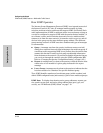
6-106
Configuring the Switch
Automatic Broadcast Control (ABC) Features
Configuring the Switch
Automatic Broadcast Control (ABC)
Features
ABC reduces the amount of IP and/or IPX broadcast traffic within a broadcast
domain without adding the levels of cost and latency normally associated with
routers. To get this result, the switch serves as a proxy for IP ARP, IPX NSQ,
and IPX GetLocal Target, and limits the forwarding of IP RIP, and IP RIP/ SAP
packets to only those ports where the broadcasts are needed. This reduces
the number of ports over which IP and/or IPX broadcasts are sent, increases
the amount of network bandwidth available for other purposes, and can
reduce the need for routers within a network. These factors can lower costs
and reduce latency in the network. (While communication between VLANs—
broadcast domains—still requires a router, ABC functions within VLANs and,
by using multiple subnets per VLAN—multi-netting, can reduce or eliminate
the need for routers within the VLAN.)
When enabled, ABC also sets the broadcast limit parameter (Bcast Limit) in
the Port Configuration screen of the console (figure 6-21) for all ports on the
switch (or selected VLAN, if VLANs are configured) that have not already been
set to a nonzero value.
In the factory default state, ABC is disabled.
Note ABC does not control AppleTalk and DECnet broadcasts. To limit these
protocols, use the protocol filter option available with Traffic/Security filters.
Refer to “Traffic/Security Filters” on page 6-46.
For further operating information and restrictions, refer to “How ABC Oper-
ates” on page 6-113.


















